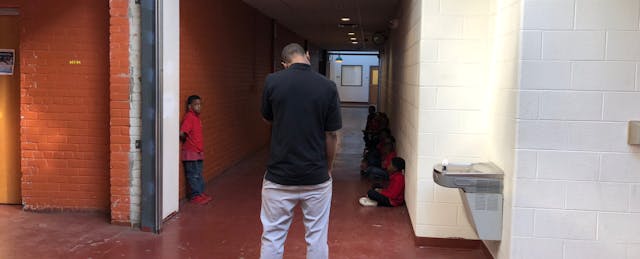The Brightmoor neighborhood in the western edge of Detroit—ravaged by poverty and gang violence, riddled with abandoned homes and boarded-up schools, and lacking public transportation options—has no shortage of wicked problems that exasperate chronic absenteeism in its schools. In fact, there is only one high school, Detroit Community Schools, a charter school, left in the area after other district-run campuses were shut down or abandoned.

Since the introduction of a school improvement plan during the 2015-16 school year, the Detroit Community High School has seen progress in attendance—going from 30 percent of students missing more than 10 percent of school days in 2015-16, to less than 5 percent in 2016-17, according to the Michigan School Data System.

Yet, making sure students get to classes and stay in them is a constant struggle for educators. As EdSurge toured the woodworking class, where high school and university students are supposed to work side-by-side on art projects, it is clear that many of the students are missing.
“That group over there,” says Bart Eddy, co-founder of the school, pointing to a cluster of students, “many of them didn't show up today.”

School leaders in Detroit say they know they have a truancy problem, even without having to refer to data showing that the city has the highest rate of chronic school absenteeism in the United States.
Marcus Lewis, a former Brightmoor student who is now an instructor in the woodshop, notes that several issues keep students from coming to school, even when they want to. He points to community problems such as constant transience, where students have to move several times in a school year because of issues with rent and homelessness, which make it difficult for them to stay in school.
Lewis first took the woodshop class when he was in 10th grade, and during that time his mother passed away, causing him and his six siblings to be scattered across different homes around the city. While he says he originally came to the woodshop “for the girls,” the teacher would only let him stay if he worked, and he found it eventually became the only thing that kept him from dropping out of school.
Eddy designed the woodshop program so students would be able to sell their creations for profit. And as Lewis built strong woodworking skills, it soon became his primary source of income. “So by the time 12th grade came I paid for my prom, and senior dues all from working here,” says Lewis. “It became like a home for me.” He notes that the ability to work and go to class is what helped him get back on track at school, even though he had to travel miles to be there.
Yet, other students in the program dealing with their own set of traumatic experiences will not see graduation.
Jay Sean, a senior working in the woodshop, lost all his siblings in a house fire during his freshman year in high school. Eddy notes that though the woodshop programs seem to have helped him build back social and emotional skills, it has not gotten him back into class.
“He was totally and completely shut down. We took him on. He wasn’t talking at the time,” says Eddy, who notes he has been working with the student since he was a freshman. “He has gotten to the point now where he can talk in front of a group. He is a senior, but he is not going to graduate. He comes to work at the woodshop, but he often does not come to school. That has been a big issue.”
The District Seeks a Data Response
Even though charter schools such as Detroit Community High School often operate under a different set of rules from traditional district schools, there are obstacles endemic across the city that affect all the communities they serve. Speaking at the Schoolzilla Data Champions Summit last Monday in midtown Detroit, Nikolai Vitti, the new superintendent of Detroit Public Schools, noted how several practices by city and state officials exacerbated truancy throughout the area.

Vitti noted how the closure of several public schools under emergency management, the lack of quality checks on “choice” schools, an inefficient bus system, and high suspension rates had effects on the truancy in schools across the city. He also recognized a need for students—who don’t have washing machines at home—to have a way to clean their clothing.
On that last point, some schools have found that providing laundry machines have drawn some students back, according to Vitti. “We are hoping to see schools that are doing a better job on attendance. We have seen schools have washers and dryers to clean clothes. That’s a little thing we don’t think about, but that helps,” he says.
The superintendent also believes that data can play a critical role in helping to sort through the many factors that contribute to truancy and test what interventions are most effective.
“Systems drive reform in order to do things better for children,” says Vitti, noting that when his administration started last May, they first assessed the district data.
Yet in order for data to be useful for the district, Vitti says it has to be “good,” meaning accurate, action-oriented and standards-aligned. At the Schoolzilla event, he noted how a culture of fear, dishonesty, and lack of fidelity in data collection resulted in information that he deems unreliable. Past datasets are so inaccurate, he believes, that the district is essentially starting from “ground zero.”
“Principals, teachers and district leaders tried to stay off the radar and just survive,” says Vitti. “So when I get asked, ‘Historically what is the rate of truancy at X school?’ I can get that data, but then I am very skeptical about what does that data really tell me when there wasn’t fidelity to actually inputting data.”
Since 2009 the district has been using a system called MISTAR to track student information such as grades and attendance, but Vitti says that is about to change. He plans to partner with Schoolzilla, a K-12 data management system provider, for a “user-friendly” tool to input and display information.
“[Schoolzilla] synthesizes all the data to make it very clear. If it is clear, it is actionable, and it becomes easy to understand what is most important,” explains Vitti.
His district has identified metrics such as student performance at grade level, growth, attendance, truancy, suspension, and how many students are eating lunch and breakfast. These indicators are tied to the district’s strategic plan, a three-year outline for improving public schools. Using the metrics, Schoolzilla will provide a custom dashboard to the district to use for the upcoming school year.
“We will start the school year next year with clear dashboards, so we can begin to view what those metrics look like at the district level [and] also at the individual schools,” explains Vitti.
However, Vitti recognizes that merely changing the data-collection platform is not enough. That is why he is also hosting “Data Chats” with school principals to improve the accuracy of information from schools. The chats put principals on the “hot seat” to explain data trends coming out of their schools. He notes that these discussions are not meant to be punitive, but to simply change the culture around data inputs, so school leaders take the work more seriously.
“The attempt is to create a culture of collaboration around data,” says Vitti. “We also start getting into issues of truancy, for example, and what we can do differently based on pockets where we don’t have transportation lines. Do we need to add a late bus in a certain neighborhood to pick up students where we are always dealing with students being late? Those aren’t theoretical conversations. They are rooted in data.”
Starting this fall, he hopes, “we will have better data and that we will also start to see schools that are doing a better job on attendance.”


